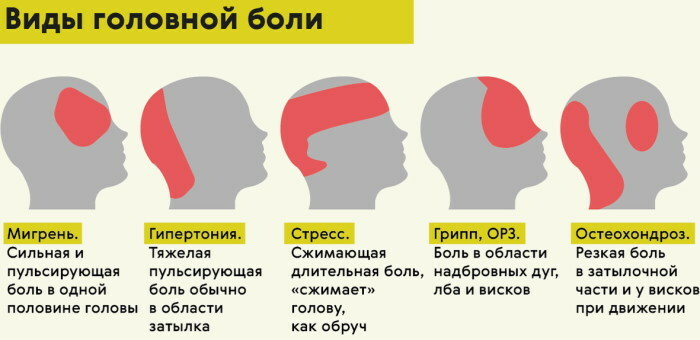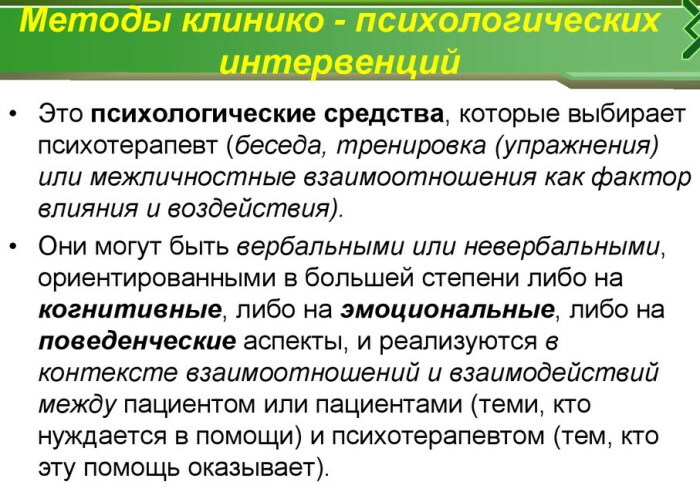Content
- Ditsynon release form
- Composition of the preparation
- Pharmacological properties
- Pharmacodynamics and pharmacokinetics
- Indications for use
- Contraindications
- How does Dicynon help eliminate uterine bleeding?
- Instructions for use, dosage
- With uterine bleeding
- With heavy and painful menstruation
- Side effects
- Overdose
- special instructions
- Drug interactions
- Analogs
- Terms, conditions of sale and storage
- Price
- Video about Dicinon
Dicinon is prescribed with uterine bleeding and heavy menstruation. The instructions for use indicate an approximate dosage regimen, dosage regimen, contraindications and side effects. The drug has several analogues.
Ditsynon release form
Dicinone for uterine bleeding (instructions for use are present in each package) has several dosage forms.
These include:
- Suspension for intravenous, intramuscular infusion. The colorless liquid is poured into transparent glass ampoules. There are 2 risks on the container (white and blue). Ampoules are packed in cardboard or plastic pallets. In a box - 10 pcs. Instructions for use are attached.
- Pills. Cream, yellowish or white, biconvex, round. The tablets are enteric coated. No chamfer and no risk. In 1 box - 10 blisters (10 tab. in each). Instructions for use are attached.
The color of the tablets may vary depending on the manufacturer.
Composition of the preparation
The active ingredient in Ditsynon (regardless of the form of release) is ethamsylate. The chemical name is dihydroxybenzenesulfonic acid containing diethylamine. The gross formula is C10H17NO5S. The substance can be considered a microcirculation corrector and a coagulant.
The composition also contains additional elements:
- milk sugar;
- stearic acid and magnesium salts;
- low molecular weight polyvinylpyrrodoline;
- corn starch;
- citric acid.
Additional components in the Dicinone solution are sodium bicarbonate, purified water and sodium bisulfite.
Pharmacological properties
Dicinone is taken for uterine bleeding. Instructions for use indicate the need to comply with a clear dosing regimen. The drug belongs to the group of angioprotectors, hemostatics.
Pharmacodynamics and pharmacokinetics
The active ingredient is characterized by an angioprotective, antihemorrhagic and hemostatic effect. With systematic use, the permeability of the vessel walls is restored, the blood circulates normally. Etamsylate is responsible for the process of platelet synthesis, accelerating their separation.
Dicinone restores elasticity to the walls of small blood vessels, inhibiting the synthesis of mediators that provoke vasodilation and disaggregation of blood cells. The drug is responsible for shortening bleeding time and reducing blood volume with it. Etamsylate helps to accelerate the synthesis of primary blood clots. It has no effect on the concentration of fibrinogen.
With the systematic use of Ditsynon, an acceleration of the process of blood clots is noted. The active substance in the hemostatic does not change the rheological properties of blood. There is a decrease in the rate of sedimentation of red blood cells. For Ditsynon, the vasoconstrictor effect is not typical.
Etamsylate helps to restore microcirculation and reduce diapedesis of blood elements from the arterial vascular bed. Dicinone can be taken during the treatment of pathologies characterized by secondary and primary disorders of blood flow. Etamsylate stabilizes ascorbic acid. With prolonged use of the drug, the vessels become less fragile.
When injected into the gastrointestinal tract, the tablets quickly disintegrate and are absorbed. The maximum concentration of ethamsylate in the blood is observed after 240 minutes. after the first application. The active ingredient in Ditsynon is able to overcome the placental barrier. The substance does not penetrate into breast milk. Ethamsylate binds to blood proteins by 92-94%.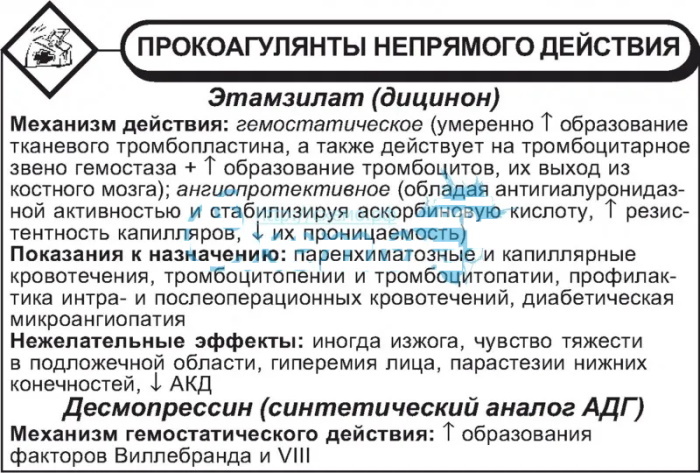
Partial metabolism. When taken orally, the active ingredient in Ditsynon leaves the body after 4 hours. Excretion is carried out by the kidneys. Taking the medication is allowed for patients suffering from kidney and liver diseases. Correction of the dosage regimen is not necessary in this case. Dicinone in the form of a solution for intravenous and intramuscular administration immediately enters the systemic circulation. Etamsylate is evenly distributed over tissues and systems.
Indications for use
Dicinone with uterine bleeding (instructions for use does not require dietary intake during the period of taking the drug) has an angioprotective effect.
The main indications for use:
- hemorrhages in the brain in newborns;
- hemophthalmus;
- retinal hemorrhage (relapse);
- rhinopathy of the diabetic type (hemorrhagic);
- bleeding gums;
- regular nosebleeds;
- prolonged uterine bleeding (menorrhagia, primary or caused by the setting of an intrauterine device);
- metrorrhagia;
- blood in the urine.
The medication can be taken during the rehabilitation period after surgery. The drug is actively used in dentistry, obstetrics, plastic surgery, ophthalmology, urology and gynecology.
Contraindications
Dicinone has a number of relative and absolute restrictions on its use. Caution is indicated for patients with thromboembolism, thrombosis and a history of bleeding caused by an overdose of anticoagulants.
Consider the following as absolute contraindications:
- hemoblastosis;
- osteosarcoma;
- myeloblastic, lymphoblastic leukemia;
- acute porphyria;
- bronchial asthma.
It is necessary to refuse taking a hemostatic for people suffering from hypersensitivity.
How does Dicynon help eliminate uterine bleeding?
Dicinone with uterine bleeding (instructions for use describe relative and absolute contraindications) restores the permeability of the vascular membranes. Before taking the drug, the attending physician must make an accurate diagnosis.
There are several main reasons for the development of uterine bleeding:
- erosion of the uterus;
- cervicitis;
- endometritis;
- infectious diseases of the genitourinary system;
- ruptured ovaries or cysts;
- the growth of neoplasms of a benign or malignant nature.
The risk group includes people suffering from:
- cirrhosis of the liver;
- diseases of blood vessels and heart;
- pathologies characterized by metabolic disorders;
- hemophilia;
- vasculitis;
- typhoid;
- dysentery.
In order to avoid large blood loss, experts recommend taking Ditsynon and providing the patient with complete rest. The drug has a stimulating, hemostatic and angioprotective effect. Etamsylate accelerates the formation and aggregation of platelets. The substance takes part in the formation of thromboplastin. This helps to reduce bleeding.
The drug is responsible for slowing down the destruction of small blood vessels. When etamsylate enters the body, capillary permeability and microcirculation are restored. The effect is noticeable after 25-40 minutes. after the first application. The therapeutic effect of Ditsynon lasts for 5-6 hours. In emergency cases, with profuse uterine bleeding, intravenous administration of the drug is indicated.
Instructions for use, dosage
The dosage regimen of Dicinona may vary depending on the patient's condition and the diagnosis made to her. The regimen, as well as the course of treatment, is selected individually. The tablets are taken orally whole, without chewing. It is not recommended to dissolve the oral form in water.
In case of retinal hemorrhages, the drug is injected retrobulbar. You can take no more than 2 tablets at a time. For parenteral administration, a single dose is 250 mg. During the rehabilitation period after surgical interventions, Dicinon is taken for 7-10 days, 1 tablet 2 times a day. Patients suffering from diabetic angiopathies, hemorrhagic diathesis and other pathologies of the hematopoietic system can take 3 Dicinon tablets per day for 14 days.
For prophylactic purposes during the rehabilitation period after operations on the uterus, the therapeutic dose is 8-10 mg / kg. With hemorrhagic syndrome, drink 1 tablet 3 times a day. The course of application is 14 days. If necessary, it can be repeated after 7 days. For diabetic microangiopathy, Dicinon's solution is administered intramuscularly 3 times a day (250 mg once). The course of application is 90 days. A cloth moistened with a solution is applied to an open wound to stop bleeding.
With uterine bleeding
In case of uterine bleeding, the drug must be taken under the supervision of the attending physician. Dicinone solution is administered intramuscularly or intravenously. Single dose - no more than 2 ampoules. Injections must be done every 5-6 hours. The course of application is determined individually.
With heavy and painful menstruation
With heavy menstruation, the drug can be taken with the permission of the doctor. Approximate dosage regimen: no more than 2 tablets once 3 times a day (several days before and during the cycle). It is necessary to drink the medicine for 3-4 months.
Side effects
Dicinone with uterine bleeding (instructions for use indicate the presence of side effects) helps to restore microcirculation.
Ailments occur with an incorrectly selected dosing regimen from the side:
- immune system - allergic reactions, which manifest themselves in the form of redness, rashes, swelling;
- musculoskeletal system - myalgia, joint pain, local fever, swelling, hyperemia;
- hematopoietic system - thrombocytopenia, a decrease in the number of neutrophils and leukocytes;
- blood vessels and heart - lowering blood pressure, blockage of blood vessels by a thrombus;
- nervous system - prolonged migraine, nervous tics, dizziness, tingling or burning sensation in the lower extremities;
-
organs of the digestive tract - various dyspeptic disorders (vomiting, nausea, diarrhea, pain in the epigastric region).
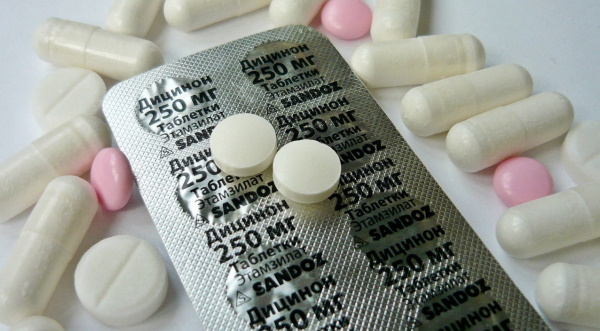
Patients may complain of asthenia.
Overdose
Overdose cases were not identified during the research. If the therapeutic (daily) dose is repeatedly exceeded, the patient's blood pressure may critically drop. With the development of dyspeptic disorders, symptomatic treatment is required.
special instructions
The drug is intended for use in a hospital setting. Before prescribing, the specialist must exclude other causes that provoked bleeding (except for those described earlier in the article). If the solution has changed color, it cannot be administered intravenously or intramuscularly. The therapeutic effect in patients with thrombocytopenia is not manifested.
Dicinone is not prescribed for hemorrhagic complications that were provoked by an overdose of anticoagulants. In this case, the patient is prescribed a specific antidote. Patients suffering from blood pathologies characterized by poor coagulability should additionally include drugs that eliminate this defect in the composition of drug therapy.
With parenteral administration of the solution, care must be taken: there is a high risk of lowering blood pressure to critical levels. The Dicinone solution contains sodium sulfide, which acts as an antioxidant. The substance can provoke dyspeptic disorders (diarrhea, nausea, vomiting) and local allergic reactions (swelling, hyperemia, rash).
In hypersensitive patients, allergies may manifest as Quincke's edema or anaphylactic shock. The risk of asthma attacks is high. The ailments that appeared during the period of Dicinon's use are the reason for the immediate discontinuation of the drug.
The solution must be administered intravenously or intramuscularly after taking it into a syringe. The unused drug is disposed of according to the standard scheme. No special precautions are required.
Drug interactions
The solution is strictly forbidden to be mixed in one syringe with other medicines. Dextrans have an antiplatelet effect, therefore Dicinon is recommended to be administered intravenously or intramuscularly for 60 minutes. before taking polysaccharides.
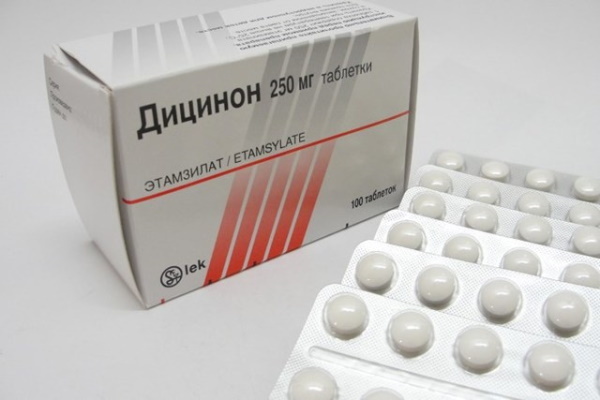
The medication can be combined with mucolytics, expectorant drugs.
Analogs
The drug has several analogues.
These include:
- Etamsilat. The drug contains sodium disulfide, sodium sulfide, disodium edetate and purified water. It comes on sale in the form of a solution for intramuscular or intravenous administration. The active substance is the component of the same name. The drug has a hemostatic (hemostatic) effect. Thromboembolism, thrombosis, hemoblastosis, porphyria (acute) are considered absolute contraindications. Hypersensitive people are advised to refrain from using the drug. Caution is indicated during pregnancy. The cost of the drug is from 70 rubles.
- Cyclohemal. The intravenous solution contains tranexamic acid. The drug has no contraindications, with the exception of hypersensitivity or individual intolerance to the active ingredient. Hemostatic helps to stop bleeding caused by increased fibrinolysis. The drug has a mild anti-inflammatory and antihistamine effect. Cost - from 100 rubles.
- Tranexam. The drug is marketed in pill form. The active ingredient is tranexamic acid. The medication is prescribed for postpartum, nasal, uterine bleeding, liver disease, hematuria, menorrhagia. It can be taken during the rehabilitation period after surgery on the chest organs. Subarachnoid hemorrhage and individual intolerance to the active ingredient are considered absolute contraindications. Cost - from 300 rubles.
- Stagemin. The drug form is a solution for intravenous administration. The active ingredient is tranexamic acid. Additional elements may vary depending on the manufacturer. The drug has a hemostatic effect. It can be used for gastrointestinal, nasal, uterine bleeding, hematuria, leukemia. The medicine has no contraindications, with the exception of individual intolerance. Cautious reception is indicated for women during the period of bearing and breastfeeding. Cost - from 600 rubles.
- Emaplag. The drug contains human thrombopoietin. Auxiliary elements - purified water, sodium chloride, serum albumin. The drug is marketed in the form of a solution. Emaplag can be considered a generic Dicynon. The drug has a number of contraindications: angiopathy of the brain and heart, thrombosis, hypersensitivity. Caution is indicated for pregnant and breastfeeding women. The medication is not prescribed for children. Cost - from 540 rubles.
Analogs, like the original drug, can provoke the development of side effects. Patients may complain of dizziness, headache, weakness, fever, chills. Any ailments are the reason for the abolition of the medication. It is strictly forbidden to independently draw up a reception scheme.
Terms, conditions of sale and storage
Dicinone, like most hemostatics, requires a prescription. The buyer must present to the pharmacist a form indicating the number of packages and the name in Latin. The drug is strictly forbidden to use as directed after the expiration date. Keep the medicine away from heating devices, children and animals.
Price
The cost of the drug may vary depending on the place of sale. Approximate prices:
| Release form | Price |
| Pills | From 350 rub. |
| Solution for i / m, i / v administration | From 420 rub. |
It is important to carefully study the annotation before use. The instruction is included in each package.
Dicinone with uterine bleeding must be taken every 5-6 hours. The instructions for use indicate an approximate dosage regimen: it is not recommended to adhere to it. The dosage regimen is selected individually, depending on the patient's condition and diagnosis.
Video about Dicinon
Dicinon. Instructions for use:

